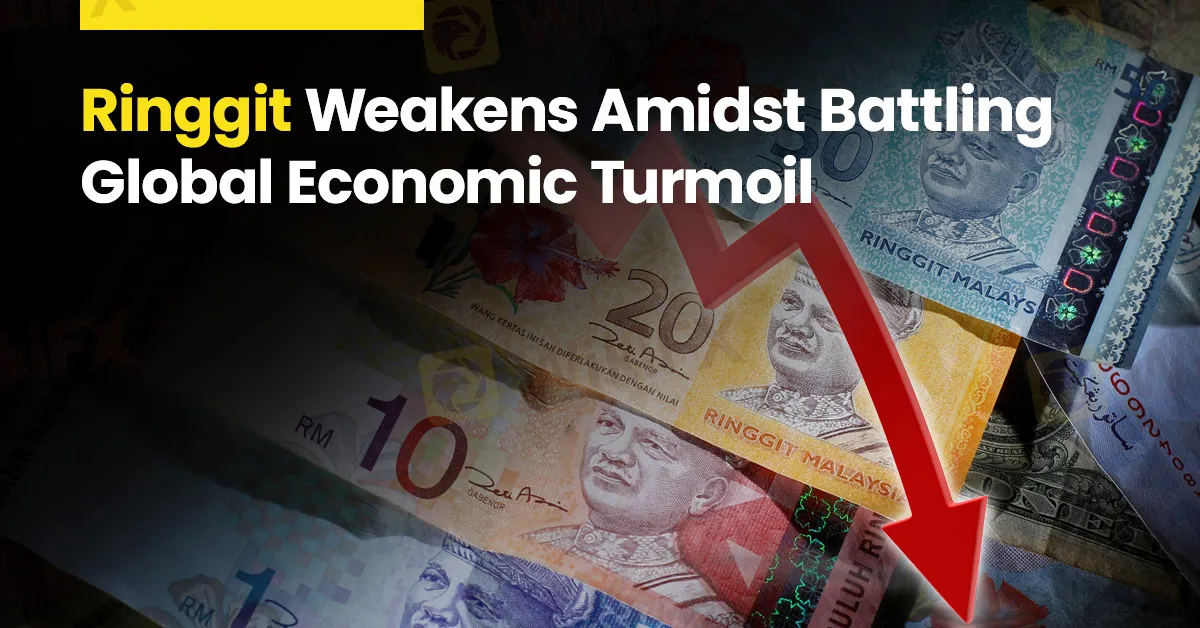简体中文
繁體中文
English
Pусский
日本語
ภาษาไทย
Tiếng Việt
Bahasa Indonesia
Español
हिन्दी
Filippiiniläinen
Français
Deutsch
Português
Türkçe
한국어
العربية
Ringgit Weakens Amidst Battling Global Economic Turmoil
Abstract:On Tuesday, the ringgit dipped to a low of 4.7900 against the US dollar, driven by apprehensive investors seeking refuge in the safe haven currency amidst escalating geopolitical tensions. Over the past week, the local currency has depreciated by nearly 0.9% against the US dollar, marking its weakest performance since January 1998. In conjunction with this decline, Bank Negara Malaysia has reiterated its commitment to bolstering the ringgit.

Bank Negara Malaysia has reiterated its commitment to bolstering the ringgit, which has neared its lowest point since January 1998. The central bank pledges to maintain the smooth operation of the foreign exchange market, with assistance from government-linked entities, corporations, and exporters. Their collective efforts aim to attract inflows and enhance liquidity within the market, as stated in a release from the central bank on Monday.
On Tuesday, the ringgit dipped to a low of 4.7900 against the US dollar, driven by apprehensive investors seeking refuge in the safe haven currency amidst escalating geopolitical tensions. Over the past week, the local currency has depreciated by nearly 0.9% against the US dollar.

This scenario is not unique to Malaysia. Investors are closely monitoring emerging-market central banks, including those of China, Korea, Thailand, Poland, and Indonesia, for potential intervention, as their local currencies have been battered by the recent surge in the dollar. In comparison, the ringgit demonstrated relative resilience compared to other regional currencies like the South Korean won, Philippine peso, and Taiwanese dollar.
Malaysia's currency struggles are part of a broader trend influenced by the dollar's strength, fuelled by expectations of prolonged high interest rates by the Federal Reserve, along with safe-haven demand amid escalating tensions in the Middle East. Additionally, the subdued economic prospects for China, Malaysia's key trading partner, have exerted downward pressure on the ringgit.
In early March, Bank Negara Malaysia's announcement to encourage state-linked entities to repatriate foreign investment income and consistently convert it into the local currency helped the ringgit recover from its February lows.
Dr. Mohd Afzanizam Abdul Rashid, Chief Economist and Head of Social Finance at Bank Muamalat Malaysia Bhd, highlighted to Business Times that during times of economic uncertainty, the US dollar typically serves as a safe haven, leading forex traders to increase their allocations to it. He further elaborated that the US Federal Reserve's cautious approach towards reducing its benchmark interest rate is supported by recent economic data, such as the 0.7% month-on-month growth in Retail Sales, surpassing consensus estimates of 0.4%.
Despite these challenges, Malaysia's status as a net oil exporter could offer some relief. With Brent oil prices approaching $100 per barrel, there is still a possibility of support for the Malaysian currency from this front.

Disclaimer:
The views in this article only represent the author's personal views, and do not constitute investment advice on this platform. This platform does not guarantee the accuracy, completeness and timeliness of the information in the article, and will not be liable for any loss caused by the use of or reliance on the information in the article.
Read more

Interactive Brokers Enhance Account Security with FDIC Coverage
Interactive Brokers now offers up to $5M FDIC insurance for individual accounts, boosting protection on cash held in brokerage accounts starting May 2025.

Vantage Markets Review 2025: Trusted Forex and CFD Trading Since 2009
Explore our 2025 Vantage Markets review! A trusted Sydney-based broker since 2009, offering forex, CFDs, low spreads, global regulation, and 24/7 support. Trade from $50!

Top Tips to Choose the Best Forex Broker in 2025
You need a solid forex broker to make the most of the currency fluctuation. The strategies they use to take you through the ups and downs of forex trading are beyond words. While the strategies may seem solid, the eventual gains matter more. That’s where you need to take notice of the forex brokers, how they approach, their fee structure, rating, etc. To help you evaluate forex brokers better, we have this guide for you. Read it to choose the right forex broker in 2025.

Rupee Continues to Fall Under Robust Demand for US Dollar
Rupee continued to fall for the sixth time in seven trading sessions on Wednesday (June 4, 2025) under robust demand for the US dollar. The Indian National Rupee slipped past 86 to the US dollar. The fall is attributable to the bullish bets made by traders for the USD. The day saw the rupee falling to 86.025 before recovering to end the day at 85.90. It was 0.4% lower than the previous day's close.
WikiFX Broker
Latest News
OctaFX Flagged by Malaysian Authorities
IronFX Broker Review 2025: A Comprehensive Analysis of Trustworthiness and Performance
Nonfarm Data Lifts Market Sentiment, U.S. Stocks Rebound Strongly
Interactive Brokers Enhances PortfolioAnalyst with New Features
Why Your Worst Enemy in Trading Might Be You
Errante Broker Review
Interactive Brokers Enhance Account Security with FDIC Coverage
SFC Issues Restriction Notice to GA (Int’l) Capital Management Limited Over Regulatory Concerns
WikiFX Forex Community Expert AMA
Exnova Forex Broker Scam: Blocked Accounts, Lost Funds
Currency Calculator


